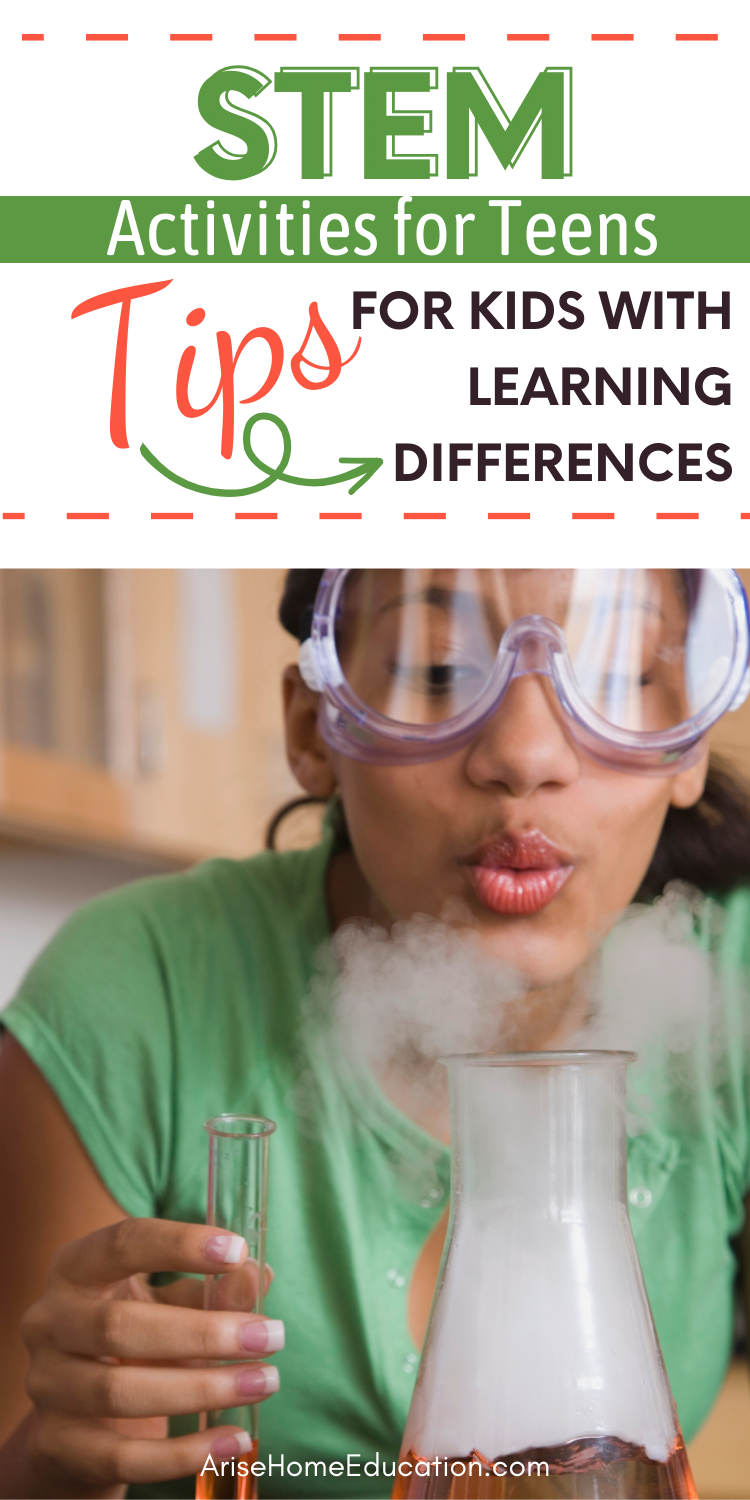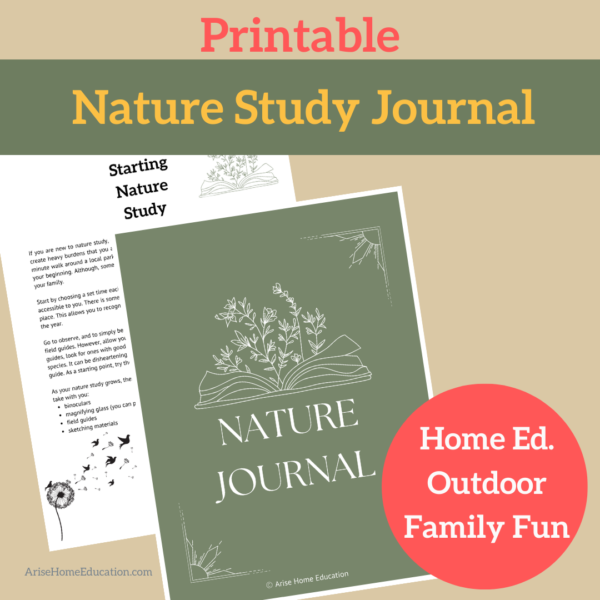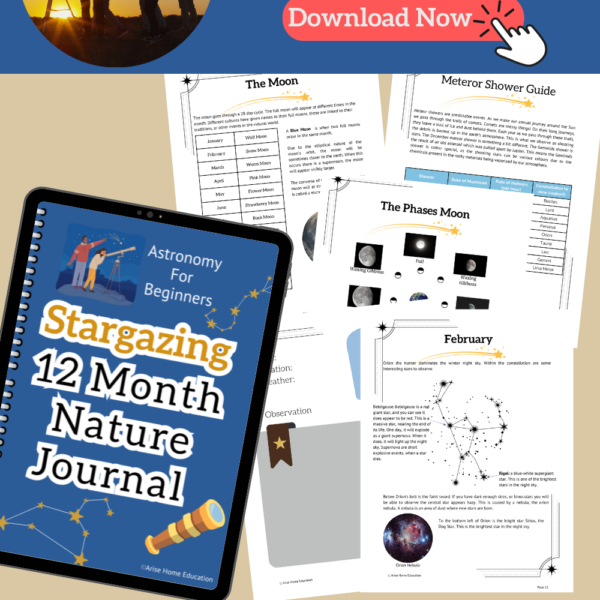
Finding STEM Activities for Teens along with a quality science curriculum can be challenging. Traditional textbook science lessons can be a challenge for kids with learning differences, or who are neurodivergent. Sadly, text-heavy dry text can turn many teenagers off science. However, some of the greatest scientists were likely to have been neurodivergent, dyslexic, or ADHD. History tells us the very challenges that so many teens have with learning differences, can be turned into their greatest strength. The capacity to think outside the box allows those who are not neurotypical to approach problems in new and unique ways.
A Learning Differences Guide for Adding STEM Activities for Teens
One of the greatest benefits we have as home educators is to be able to tailor our kids’ education to their particular needs. Teens with ADHD have a shorter attention span. Therefore, we can provide academic learning in smaller chunks with more time to move about. We can also be more intentional in how we tailor learning and make it more multisensory. We can choose a curriculum that is less text-heavy. There is also the freedom to go at the pace out the child, and not what is dictated to by the classroom. Middle school and older kids really thrive with this approach.
Although we are considering STEM education with teens, it is worth noting that providing younger kids with opportunities to explore STEM activities and talking with them about the natural world around them will make science a part of their life. So as high schoolers their science education is a continuation of a conversation that has been ongoing all their lives.
STEM Ideas and Activities for Teens
Doing hands-on activities will be more engaging for kids who are neurodivergent. Building science around STEM projects is a great opportunity to explore ideas and principles with a simple science experiment with a positive impact. Even activities that require little time can be used to explore deeper concepts behind them. The Crest Award has an extensive library for all ages, over all the disciplines of science. These are designed to be completed over a longer period for high school students. They are also a great way to achieve certificates which can be added to a CV or UCAS form, the equivalents to a resume and college admission application in America.
Engineering is a fantastic field to explore for kids who are neurodivergent. The critical thinking and processes involved facilitate out-of-the-box thinking and hands-on learning often using creative and unusual supplies. Working through a book of engineering projects or looking to see if there is an engineering club in your region are great ways to encourage young scientists to explore the world around them. The James Dyson Foundation also has a range of activities that are designed for homeschoolers to do at home, with simple supplies that are readily available. These challenges are engaging, real-world problems, that encourage problem-solving.
Creative STEM Activities for Teens to Explore Key Principles of Science
Many teens with ADHD love video games. And although as parents we want to limit the screen time our kids have, we can also harness that motivation to create a great time of improving their STEM skills by using coding activities to explore STEM principles. NASA has coding activities to engage teens, such as coding a Mars rover to making a moon rover game. A fun coding project can open the door to deeper computer science learning.
Human biology can be a great field of study. Experiments can be designed to explore the effects of exercise on heart rate. This can be done with the whole family. Compare how exercise affects the heart rate and recovery times of different members of the family – does age, gender, or fitness levels make a difference? Such experiments are a great challenge and a fun way to introduce the scientific method to teens. They are also able to design an experiment of their own, with their own hypothesis, and test it.
Building models is also an engaging exercise, that is highly kinaesthetic. A few ideas would be building spaghetti towers, and testing the height and strength of different designs, this work on engineering skills; catapults with craft sticks and rubber bands; build a model of the solar system with papier-mâché, or a to-scale model of the Solar System, making each planet in proportion to each other, this also brings in mathematical concepts or proportion and scale into the process.
-
Product on sale
 Cambridge Combined Science Year 1Original price was: £320.00.£300.00Current price is: £300.00.
Cambridge Combined Science Year 1Original price was: £320.00.£300.00Current price is: £300.00. -
Product on sale
 iGCSE Physics Year 1Original price was: £320.00.£300.00Current price is: £300.00.
iGCSE Physics Year 1Original price was: £320.00.£300.00Current price is: £300.00. -
Product on sale
 Astronomy Sample Lesson: Intro to Astronomy CurriculumOriginal price was: £9.00.£0.00Current price is: £0.00.
Astronomy Sample Lesson: Intro to Astronomy CurriculumOriginal price was: £9.00.£0.00Current price is: £0.00. -
 Astronomy Curriculum: A Self-Paced Introduction for High School£140.00
Astronomy Curriculum: A Self-Paced Introduction for High School£140.00 -
Product on sale
 High School GCSE Astronomy: Year 1Original price was: £320.00.£300.00Current price is: £300.00.
High School GCSE Astronomy: Year 1Original price was: £320.00.£300.00Current price is: £300.00.
Summertime STEM Activities for Teens
Some fun STEM ideas for summer holiday time are: use an old cardboard box and aluminum foil to make a solar oven, this is a fun science activity for the whole family, learn about solar radiation. You could also make ice cream in a bag, this teaches the concepts of freezing point, and how to alter the freezing point of water with salt. During the summer solstice, connect with the Schools Observatory project Solstick– this uses the position of the sun at noon around 21st June to measure the circumference of the earth.
Hands-On Biology
Biology can be made more hands-on by exploring the ecosystems in your neighbourhood. Get outside and study what is growing an living in your neighbourhood. Invest in a microscope to see what microorganisms are living in a local pond. Jean-Henri Faber to Beatrix Potter began their scientific discoveries in their local neighbourhoods observing what was around them, sketching, studying, and watching the natural world. Did you know Beatrix Potter (homeschooled!) was the first person to discover lichen are an algae and fungi in a symbiotic relationship? She catalogued all the fungi around her Lake District home.
Chemistry At Home
Chemistry can be explored through experiments with household items. Looking at chemical reactions, and the evidence that chemical reactions occur. Although there may be an initial investment, and time to be prepared, kids who are neurodivergent (and neurotypical kids) love to experience science happening and not simply written about in a textbook. Using molecule kits is another kinesthetic way of exploring chemistry. This allows kids not only to be touching, and making; but it also creates the 3D visual representation of a molecule, which opens up the underlying concepts of valence and bonding.
Fun with Physics
Similarly, physics activities use hands-on activities to underpin learning. Snap Circuits are a fantastic way of giving a child the real experience of building circuits. Simple machines can demonstrate many key ideas of the physics of motion. Even fun stem activities like a balloon car or coke and mentos rock show Newton’s Third Law of motion.
Science Is Everywhere
Science is truly everywhere! The world around us is shaped by the laws of physics, the chemical reactions within a biological system, and the rules of mathematics. Therefore, kids who are not “sciency” may be engaged by scientific and mathematical ideas taught via art or music. For example, the Crest Award has a project for students to design and make a pendent. Although pendant making appears more handicraft than a science activity, students learn that the creative process of planning and designing has many STEM ideas underpinning it. Students engage in the press by choosing the type of wood to use or understanding the toxicity of paints and how that affects their choice.
Music is also deeply mathematical, and the study of acoustics is a branch of physics in its own right. Pique your teen’s interest in physics by looking at how to make sounds, and asking questions like “What is needed to produce a particular sound?” Perhaps make your own simple musical instrument from household items? Can you build a “simple guitar”?
There are also a wide selection of STEM board games. In general, board games are fantastic educational tools. They are a fun way to reinforce learning, build critical thinking skills, and collaboration. There are board games which cover everything from the biology of a cell, coding, logic, the periodic table of elements, and astronomy. Although these can be expensive perhaps start a teen’s STEM board games club, or run a session as part of a home school coop. These can be particularly beneficial to teens with ASD, and it can be a gentle way to help with socialisation and anxiety. Although not directly a STEM board game, chess is an excellent game for improving logic skills, and chess clubs are becoming more popular.
Field Trips & STEM Activities for Teens
STEM-inspired field trips! This might be a visit to the local science museum. Many science museums have excellent educational programs, these can be accessed by home school groups, and are usually heavily discounted. Look for observatories in your area, they sometimes have evening programs for members of the public to come and learn and observe the night sky. Visit a national park and explore the ecology of the area, discover what makes it important. Research if there is anywhere nearby where you can find fossils, and go on a fossil hunt. Museums of flight and transport are also great places to explore. And for days when you may be stuck at home, don’t forget about adding a virtual educational field trip to your teen’s day.
Teens may also be interested in gaining real-life experience by volunteering at a nature reserve or a young ranger scheme. Most national parks have their own young ranger programs. These provide excellent work experience and are also great to have on a C.V. or UCAS application.
Science Curriculum that Supports Learning Differences
Kids who have learning differences often need more guidance and support in their education. Therefore, self-paced classes, unless well monitored by the parents, can often be challenging. Live online classes are typically a better option, as there is a tutor who is setting work and there is greater accountability. If you register for a live online class, ensure the provider knows of any learning differences beforehand, and discuss any accommodations that might be necessary.
When choosing a science course for a teen, it is important the course will suitably cover the range of science concepts that are grade-appropriate. Regularly as home educators, simple experiments can be used to explore deep concepts. And if you are creating a high school transcript then it is essential the course is at the high school level, and has the required hours of learning. Furthermore, when looking at online classes, it is critical to ask questions. If there is an hour of lecturing with little student interaction, your ADHD kid might not be able to stay focused. Look for online classes that are engaging and interactive. Contact providers and ask for sample lessons or lesson plans to help you in the decision-making process.
Gaining Science Qualifications
Having science qualifications is typically necessary when applying for a vast range of courses or jobs. However, it is frequently the case teens do not know which science to take. If this is the case, consider iGCSE Combined Science which covers a selection of biology, chemistry, and physics. For teens who are not passionate about science, and simply require a science, this is a great option.
Home educators have the joy of being able to educate to a child’s interest. This is even more important for the neurodivergent kid! Therefore, you can explore more unusual science courses like GCSE Astronomy. Some colleges and universities will also accept Computer Science as the required “science”.
-
Product on sale
 Cambridge Combined Science Year 1Original price was: £320.00.£300.00Current price is: £300.00.
Cambridge Combined Science Year 1Original price was: £320.00.£300.00Current price is: £300.00. -
Product on sale
 iGCSE Physics Year 1Original price was: £320.00.£300.00Current price is: £300.00.
iGCSE Physics Year 1Original price was: £320.00.£300.00Current price is: £300.00. -
Product on sale
 Pre-iGCSE MathsOriginal price was: £320.00.£300.00Current price is: £300.00.
Pre-iGCSE MathsOriginal price was: £320.00.£300.00Current price is: £300.00. -
Product on sale
 High School Spanish 1Original price was: £320.00.£300.00Current price is: £300.00.
High School Spanish 1Original price was: £320.00.£300.00Current price is: £300.00. -
Product on sale
 Logic & Debate: High School ApologeticsOriginal price was: £320.00.£300.00Current price is: £300.00.
Logic & Debate: High School ApologeticsOriginal price was: £320.00.£300.00Current price is: £300.00. -
Product on sale
 Higher Maths SQAOriginal price was: £320.00.£300.00Current price is: £300.00.
Higher Maths SQAOriginal price was: £320.00.£300.00Current price is: £300.00.
Science Gifted-ness and Learning Differences
Many neurodivergent teens may have a particular gifting in science but are not able to take exams. This is where the US model of high school education can be used. Families can curate a STEM-filled high school education, with learning at the high school level, and build a high school transcript. Students will need to sit the SAT, however, this can be taken multiple times and left until the teen is ready to do so. With the high school transcript, everything counts towards that proof of education. Arise Home Education has a course to help U.K. parents navigate the U.S. model and how to demystify the whole process.
Enriching and Engaging STEM Activities for Teens
STEM education can be an enriching and engaging process for neurodivergent teens. And the world needs what these out-of-the-box thinkers have to offer. The way they approach problems and their ability to find creative solutions to real-life problems is clear. The number of neurodivergent people throughout history who have excelled in their fields, and become world leaders and shapers in the sciences, testifies to this. However, we need to provide them with the education they need to succeed. Finding the keys to unlock their passion and creativity as they explore the world around them.
More Science Information And Resources
- Astronomy Curriculum For High School: A Faith-Based Guide
- What To Look For in a High School Astronomy Curriculum
- Science Activities for Teens: 12 Summer Vacation Ideas






